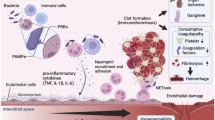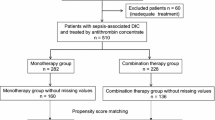Abstract
Purpose
Sepsis induces hypercoagulability, hypofibrinolysis, microthrombosis, and endothelial dysfunction leading to multiple organ failure. However, not all studies reported benefit from anticoagulation for patients with severe sepsis, and time courses of coagulation abnormalities in septic shock are poorly documented. Therefore, the aim of this prospective observational cohort study was to describe the coagulation profile of patients with septic shock and to determine whether alterations of the profile are associated with hospital mortality.
Methods
Thirty-nine patients with septic shock on ICU admission were prospectively included in the study. From admission to day 7, analytical coagulation tests, thrombin generation (TG) assays, and thromboelastometric analyses were performed and tested for association with survival.
Results
Patients with septic shock presented on admission prolongation of prothrombin time, activated partial thromboplastin time (aPTT), increased consumption of most procoagulant factors as well as both delay and deficit in TG, all compatible with a hypocoagulable state compared with reference values (P < 0.001). Time courses revealed a persistent hypocoagulability profile in non-survivors as compared with survivors. From multiple logistic regression, prolonged aPTT (P = 0.007) and persistence of TG deficit (P = 0.024) on day 3 were strong predictors of mortality, independently from disease severity scores, disseminated intravascular coagulation score, and standard coagulation tests on admission.
Conclusions
Patients with septic shock present with hypocoagulability at the time of ICU admission. Persistence of hypocoagulability assessed by prolonged aPTT and unresolving deficit in TG on day 3 after onset of septic shock is associated with greater hospital mortality.




Similar content being viewed by others
References
Amaral A, Opal SM, Vincent JL (2004) Coagulation in sepsis. Intensive Care Med 30:1032–1040
Borgel D, Bornstain C, Reitsma PH, Lerolle N, Gandrille S, Dali-Ali F, Esmon CT, Fagon JY, Aiach M, Diehl JL (2007) A comparative study of the protein C pathway in septic and nonseptic patients with organ failure. Am J Respir Crit Care Med 176:878–885
Monroe DM, Hoffman M (2006) What does it take to make the perfect clot? Arterioscler Thromb Vasc Biol 26:41–48
Gando S, Nanzaki S, Sasaki S, Aoi K, Kemmotsu O (1998) Activation of the extrinsic coagulation pathway in patients with severe sepsis and septic shock. Crit Care Med 26:2005–2009
Franco RF, de Jonge E, Dekkers PE, Timmerman JJ, Spek CA, van Deventer SJ, van Deursen P, van Kerkhoff L, van Gemen B, ten Cate H, van der Poll T, Reitsma PH (2000) The in vivo kinetics of tissue factor messenger RNA expression during human endotoxemia: relationship with activation of coagulation. Blood 96:554–559
Degen JL, Bugge TH, Goguen JD (2007) Fibrin and fibrinolysis in infection and host defense. J Thromb Haemost 5(Suppl 1):24–31
Psuja P, Zozulinska M, Turowiecka Z, Cieslikowski W, Vinazzer H, Zawilska K (2002) Plasma markers of hypercoagulability in patients with serious infections and risk of septic shock. Clin Appl Thromb Hemost 8:225–230
Abraham E, Reinhart K, Opal S, Demeyer I, Doig C, Rodriguez AL, Beale R, Svoboda P, Laterre PF, Simon S, Light B, Spapen H, Stone J, Seibert A, Peckelsen C, De Deyne C, Postier R, Pettila V, Artigas A, Percell SR, Shu V, Zwingelstein C, Tobias J, Poole L, Stolzenbach JC, Creasey AA (2003) Efficacy and safety of tifacogin (recombinant tissue factor pathway inhibitor) in severe sepsis: a randomized controlled trial. JAMA 290:238–247
Wunderink RG, Laterre PF, Francois B, Perrotin D, Artigas A, Vidal LO, Lobo SM, Juan JS, Hwang SC, Dugernier T, LaRosa S, Wittebole X, Dhainaut JF, Doig C, Mendelson MH, Zwingelstein C, Su G, Opal S (2011) Recombinant tissue factor pathway inhibitor in severe community-acquired pneumonia: a randomized trial. Am J Respir Crit Care Med 183:1561–1568
Warren BL, Eid A, Singer P, Pillay SS, Carl P, Novak I, Chalupa P, Atherstone A, Penzes I, Kubler A, Knaub S, Keinecke HO, Heinrichs H, Schindel F, Juers M, Bone RC, Opal SM (2001) Caring for the critically ill patient. High-dose antithrombin III in severe sepsis: a randomized controlled trial. JAMA 286:1869–1878
Wiedermann CJ, Hoffmann JN, Juers M, Ostermann H, Kienast J, Briegel J, Strauss R, Keinecke HO, Warren BL, Opal SM (2006) High-dose antithrombin III in the treatment of severe sepsis in patients with a high risk of death: efficacy and safety. Crit Care Med 34:285–292
Bernard GR, Vincent JL, Laterre PF, LaRosa SP, Dhainaut JF, Lopez-Rodriguez A, Steingrub JS, Garber GE, Helterbrand JD, Ely EW, Fisher CJ Jr (2001) Efficacy and safety of recombinant human activated protein C for severe sepsis. N Engl J Med 344:699–709
Abraham E, Laterre PF, Garg R, Levy H, Talwar D, Trzaskoma BL, Francois B, Guy JS, Bruckmann M, Rea-Neto A, Rossaint R, Perrotin D, Sablotzki A, Arkins N, Utterback BG, Macias WL (2005) Drotrecogin alfa (activated) for adults with severe sepsis and a low risk of death. N Engl J Med 353:1332–1341
Dhainaut JF, Antonelli M, Wright P, Desachy A, Reignier J, Lavoue S, Charpentier J, Belger M, Cobas-Meyer M, Maier C, Mignini MA, Janes J (2009) Extended drotrecogin alfa (activated) treatment in patients with prolonged septic shock. Intensive Care Med 35:1187–1195
Yamakawa K, Fujimi S, Mohri T, Matsuda H, Nakamori Y, Hirose T, Tasaki O, Ogura H, Kuwagata Y, Hamasaki T, Shimazu T (2011) Treatment effects of recombinant human soluble thrombomodulin in patients with severe sepsis: a historical control study. Crit Care 15:R123
Finfer S, Ranieri VM, Thompson BT, Barie PS, Dhainaut JF, Douglas IS, Gardlund B, Marshall JC, Rhodes A (2008) Design, conduct, analysis and reporting of a multi-national placebo-controlled trial of activated protein C for persistent septic shock. Intensive Care Med 34:1935–1947
Levi M, Ten Cate H (1999) Disseminated intravascular coagulation. N Engl J Med 341:586–592
Sakr Y, Dubois MJ, De Backer D, Creteur J, Vincent JL (2004) Persistent microcirculatory alterations are associated with organ failure and death in patients with septic shock. Crit Care Med 32:1825–1831
van der Poll T, Opal SM (2008) Host-pathogen interactions in sepsis. Lancet Infect Dis 8:32–43
Hemker HC, Al Dieri R, De Smedt E, Beguin S (2006) Thrombin generation, a function test of the haemostatic-thrombotic system. Thromb Haemost 96:553–561
van Veen JJ, Gatt A, Makris M (2008) Thrombin generation testing in routine clinical practice: are we there yet? Br J Haematol 142:889–903
Luddington RJ (2005) Thrombelastography/thromboelastometry. Clin Lab Haematol 27:81–90
Dargaud Y, Lienhart A, Negrier C (2010) Prospective assessment of thrombin generation test for dose monitoring of bypassing therapy in hemophilia patients with inhibitors undergoing elective surgery. Blood 116:5734–5737
Tripodi A, Legnani C, Chantarangkul V, Cosmi B, Palareti G, Mannucci PM (2008) High thrombin generation measured in the presence of thrombomodulin is associated with an increased risk of recurrent venous thromboembolism. J Thromb Haemost 6:1327–1333
Tripodi A, Branchi A, Chantarangkul V, Clerici M, Merati G, Artoni A, Mannucci PM (2011) Hypercoagulability in patients with type 2 diabetes mellitus detected by a thrombin generation assay. J Thromb Thrombolysis 31:165–172
Collins PW, Macchiavello LI, Lewis SJ, Macartney NJ, Saayman AG, Luddington R, Baglin T, Findlay GP (2006) Global tests of haemostasis in critically ill patients with severe sepsis syndrome compared to controls. Br J Haematol 135:220–227
Petros S, Kliem P, Siegemund T, Siegemund R (2012) Thrombin generation in severe sepsis. Thromb Res 129:797–800
Gonano C, Sitzwohl C, Meitner E, Weinstabl C, Kettner SC (2006) Four-day antithrombin therapy does not seem to attenuate hypercoagulability in patients suffering from sepsis. Crit Care 10:R160
Daudel F, Kessler U, Folly H, Lienert JS, Takala J, Jakob SM (2009) Thromboelastometry for the assessment of coagulation abnormalities in early and established adult sepsis: a prospective cohort study. Crit Care 13:R42
Adamzik M, Eggmann M, Frey UH, Gorlinger K, Brocker-Preuss M, Marggraf G, Saner F, Eggebrecht H, Peters J, Hartmann M (2010) Comparison of thromboelastometry with procalcitonin, interleukin 6, and C-reactive protein as diagnostic tests for severe sepsis in critically ill adults. Crit Care 14:R178
Adamzik M, Langemeier T, Frey UH, Gorlinger K, Saner F, Eggebrecht H, Peters J, Hartmann M (2011) Comparison of thrombelastometry with simplified acute physiology score II and sequential organ failure assessment scores for the prediction of 30-day survival: a cohort study. Shock 35:339–342
Kinasewitz GT, Yan SB, Basson B, Comp P, Russell JA, Cariou A, Um SL, Utterback B, Laterre PF, Dhainaut JF (2004) Universal changes in biomarkers of coagulation and inflammation occur in patients with severe sepsis, regardless of causative micro-organism [ISRCTN74215569]. Crit Care 8:R82–R90
Russell JA, Singer J, Bernard GR, Wheeler A, Fulkerson W, Hudson L, Schein R, Summer W, Wright P, Walley KR (2000) Changing pattern of organ dysfunction in early human sepsis is related to mortality. Crit Care Med 28:3405–3411
Monchi M, Berghmans D, Ledoux D, Canivet JL, Dubois B, Damas P (2004) Citrate vs. heparin for anticoagulation in continuous venovenous hemofiltration: a prospective randomized study. Intensive Care Med 30:260–265
Angstwurm MW, Dempfle CE, Spannagl M (2006) New disseminated intravascular coagulation score: a useful tool to predict mortality in comparison with Acute Physiology and Chronic Health Evaluation II and Logistic Organ Dysfunction scores. Crit Care Med 34:314–320 (quiz 328)
Lang T, Bauters A, Braun SL, Potzsch B, von Pape KW, Kolde HJ, Lakner M (2005) Multi-centre investigation on reference ranges for ROTEM thromboelastometry. Blood Coagul Fibrinolysis 16:301–310
Devreese K, Wijns W, Combes I, Van kerckhoven S, Hoylaerts MF (2007) Thrombin generation in plasma of healthy adults and children: chromogenic versus fluorogenic thrombogram analysis. Thromb Haemost 98:600–613
Vincent JL, Rello J, Marshall J, Silva E, Anzueto A, Martin CD, Moreno R, Lipman J, Gomersall C, Sakr Y, Reinhart K (2009) International study of the prevalence and outcomes of infection in intensive care units. JAMA 302:2323–2329
Laterre PF, Levy H, Clermont G, Ball DE, Garg R, Nelson DR, Dhainaut JF, Angus DC (2004) Hospital mortality and resource use in subgroups of the recombinant human activated protein C worldwide evaluation in severe sepsis (PROWESS) trial. Crit Care Med 32:2207–2218
Stegenga ME, van der Crabben SN, Blumer RM, Levi M, Meijers JC, Serlie MJ, Tanck MW, Sauerwein HP, van der Poll T (2008) Hyperglycemia enhances coagulation and reduces neutrophil degranulation, whereas hyperinsulinemia inhibits fibrinolysis during human endotoxemia. Blood 112:82–89
Lissalde-Lavigne G, Combescure C, Muller L, Bengler C, Raillard A, Lefrant JY, Gris JC (2008) Simple coagulation tests improve survival prediction in patients with septic shock. J Thromb Haemost 6:645–653
Fourrier F, Chopin C, Goudemand J, Hendrycx S, Caron C, Rime A, Marey A, Lestavel P (1992) Septic shock, multiple organ failure, and disseminated intravascular coagulation. Compared patterns of antithrombin III, protein C, and protein S deficiencies. Chest 101:816–823
Acknowledgments
The authors thank the medical and nursing staff of the ICU at the University Hospital of Liege for their contribution to the study, Pierre Goffin, Marie-Pierre Damas, and Charlotte Ponte for their scientific contribution as medical research students, Joelle Lefrancq for helping with patient recruitment, and lab technicians and biologists for TG/ROTEM participation. Fonds d’Investissement de Recherche scientifique, CHU Liege, Fonds de la Recherche scientifique médicale, Brussels, Belgium.
Conflicts of interest
None.
Author information
Authors and Affiliations
Corresponding author
Electronic supplementary material
Below is the link to the electronic supplementary material.
Rights and permissions
About this article
Cite this article
Massion, P.B., Peters, P., Ledoux, D. et al. Persistent hypocoagulability in patients with septic shock predicts greater hospital mortality: impact of impaired thrombin generation. Intensive Care Med 38, 1326–1335 (2012). https://doi.org/10.1007/s00134-012-2620-2
Received:
Accepted:
Published:
Issue Date:
DOI: https://doi.org/10.1007/s00134-012-2620-2




